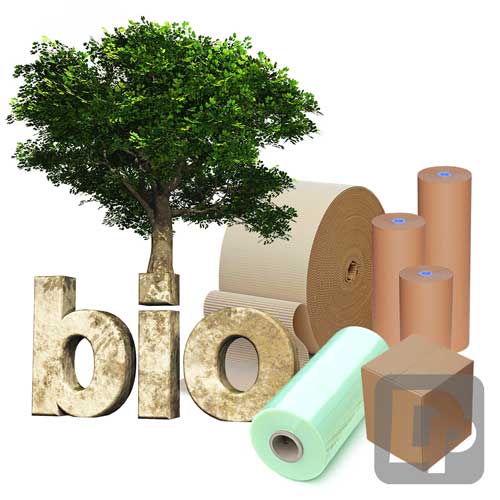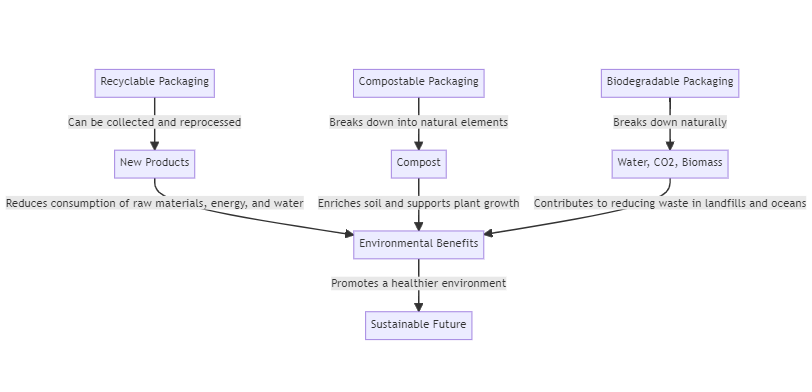Sustainable Packaging Unwrapped: Recyclable, Compostable, and Biodegradable Explained
In an epoch where environmental consciousness is more than a trending hashtag, delving deeper into the various packaging options available is essential. Packaging is often the initial interface between consumers and products, and its environmental ramifications are vast. With such significance, it's crucial to comprehend the differences and applications of recyclable, compostable, and biodegradable packagings.
Recyclable Packaging: The Pillar of Circular Economy
Central to the sustainable packaging movement is recyclable material. Its core principle lies in its ability to undergo transformation and reincarnation, emerging anew without relying on fresh resources.
Defining Characteristics of Recyclable Packaging:
- Reusability: Recyclable materials distinguish themselves by their resilience. Their quality doesn't diminish substantially, even after undergoing multiple recycling processes.
- Material Conservation: A lesser-known advantage of recycling is its ability to ensure the sustainability of natural resources. For every item recycled, there's a corresponding decrease in the demand for virgin materials.
- Economic Implications: Beyond its environmental advantages, recycling offers tangible economic benefits. Incorporating recycled materials often costs less than sourcing and processing new raw materials.
Noteworthy Examples: Widely recognised materials like aluminium, certain types of plastics like PET and HDPE, glass, and the majority of cardboard and paper products. Packaging manufactured from these materials are usually easily recycled.
Environmental Insights: The recycling process substantially curtails the need for landfills. Additionally, it consumes less energy and emits fewer greenhouse gases compared to the processing of virgin resources.
 Compostable Packaging: Nature's Own Recycling Process
Compostable Packaging: Nature's Own Recycling Process
While recyclable and biodegradable packagings have their merits, compostable materials hold a unique position. They're designed not just to degrade but to contribute positively to the environment in the process.
Defining Characteristics of Compostable Packaging:
- Swift Decomposition: In ideal composting conditions, these materials transform into their natural components in a matter of weeks or a few months.
- Purity in Decomposition: A genuine compostable substance ensures that no remnants, toxins, or harmful substances are left behind as it disintegrates.
- Carbon Balancing Act: The CO2 emissions during the decomposition of organic compostable materials equal the CO2 they absorbed during growth, rendering the process carbon-neutral.
Noteworthy Examples: Innovative materials like cornstarch packaging, some avant-garde plant-based plastics, and naturally uncoated paper.
Environmental Insights: Besides preventing methane emissions from landfills, composting rejuvenates the soil. It enhances soil structure, promotes water retention, and replenishes nutrient content.
Biodegradable Packaging: Nature's Timeline
Biodegradability is a concept often misunderstood. It encompasses materials designed to disintegrate naturally over varied timeframes and conditions.
Defining Characteristics of Biodegradable Packaging:
- Nature's Mechanisms: Biodegradable materials rely on the inherent processes of the environment for decomposition.
- Variability in Decomposition: Depending on numerous factors, including material composition and environmental conditions, biodegradability can range from weeks to several years.
- Imperfection in Decomposition: Contrary to popular belief, not all biodegradable substances disappear without a trace. Some only degrade up to a point, leaving behind minute particles.
Noteworthy Examples: Green alternatives like PLA (polylactic acid) plastics, specific bio-films, and select natural fabrics.
Environmental Insights: In landfills devoid of oxygen, biodegradable substances might produce methane, a greenhouse gas. However, in the right settings, they can significantly mitigate long-lasting waste.
Informed Choices: The Sustainable Packaging Matrix
Making an informed choice among these sustainable packaging options requires an alignment with both product necessities and overarching environmental philosophies.
- Recyclable Packaging: A go-to choice for businesses in regions with robust recycling infrastructures and for those keen on supporting a circular economy model.
- Compostable Packaging: Ideal for industries involved with organic or perishable goods. However, leveraging its potential requires either a personal composting initiative or partnerships with composting facilities.
- Biodegradable Packaging: Best suited for situations where packaging might be inadvertently discarded in non-designated areas, minimising long-term environmental damage.
The Bigger Picture and Future Trajectories
While understanding these three packaging types is imperative, it's equally important to visualise them within the broader context of global sustainability. It's not merely about choosing one over the other, but recognising their interconnectedness and potential synergies. The future of sustainable packaging is likely to involve hybrid solutions, combining the strengths of recyclability, compostability, and biodegradability.
Furthermore, research and innovation are bound to play pivotal roles, unveiling newer materials and processes that further diminish our ecological footprint. The challenge lies not just in the creation but in the widespread adoption and adaptation of these solutions by industries, governments, and consumers alike.
Conclusion
The environmental narratives of the present decade are shaped substantially by the choices we make, and packaging stands at this critical juncture. By unravelling the complexities of recyclable, compostable, and biodegradable packagings, stakeholders empower themselves to foster a future where convenience harmonises with conservation. As the guardians of tomorrow, our actions and inclinations today will echo in the sustainability legacies we leave behind.

Sustainable Packaging Unwrapped: Recyclable, Compostable, and Biodegradable Explained